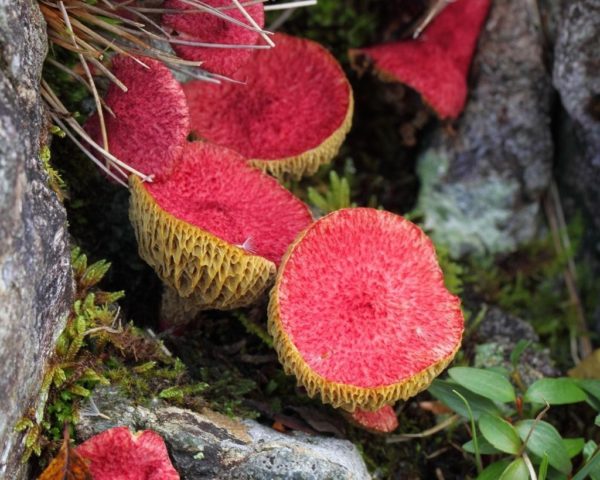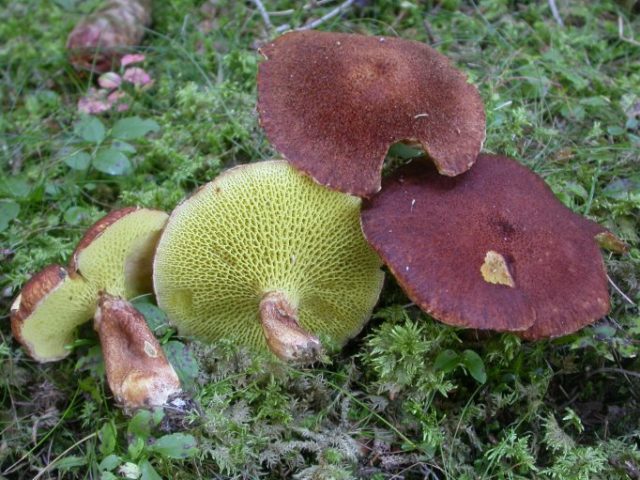Content
Marsh boletin (Boletinus paluster) is a mushroom with an unusual name. Everyone knows russula, aspen mushrooms, milk mushrooms and others. And this representative is completely unfamiliar to many. It has marsh boletin and other names: ivanchik, marsh sieve, false oil can. Maybe once the mushroom came into view during a quiet hunt, but the eye noted it as inedible.
What does marsh boletin look like?
The fruiting body of the fungus is formed by a cap and a leg.
Boletin marsh is referred to as tubular mushrooms. The upper part of the cap is always dry, velvety to the touch, and may be downy. Diameter - up to 10 cm, different color - burgundy, bright red. As the mushroom ages, the cap turns pale, acquires a yellowish color. The shape is rounded, flat-convex with a small tubercle in the middle part.
In its lower part there is a tubular hymenophore, which diverges in a radial direction. Sometimes it almost turns into records. The tubular part of the marsh boletin is yellow, then takes on an ocher tint, turns brown. The hymenophore is strongly lowered on the pedicle. In very young specimens, the bottom of the cap is hidden under a blanket. As it grows, it breaks and is noticeable on the leg in the form of a ring or scraps along the edge of the cap.
Spores in marsh boletin are light brown in color.
The leg is in a central position in relation to the head or slightly offset. Has a velvety-scaly appearance. Thickness - up to 2 cm, length - about 5 cm. In the upper part it is yellow, and under the ring it has a red color. The color is lighter in comparison with the cap.
The flesh of the marsh boletin is yellow, sometimes with a blue tint. Has a bitter taste. In young specimens, the smell is insignificant. The old ones have an unpleasant one.
Where does marsh boletin grow?
Boletin marsh grows on the surface of the earth, sometimes on rotting wood. Prefers deciduous and mixed forests. Humidification of the growing area can be either excessive or insufficient. The species can be harvested from early July to late September. More often forms mycorrhiza with larch, but sometimes it can create symbiosis with other trees.
Boletin marsh is found in the forests:
- Siberia;
- The Far East;
- North America;
- Asia.
In the European part of Russia, the fungus is found in cultivated forest plantations or other areas.
Is it possible to eat marsh boletin
According to the classification, marsh boletin belongs to the group of conditionally edible mushrooms. Abroad, it is considered inedible because of its pronounced bitter taste. The Slavs have long been using it for food.
Mushroom taste
Marsh boletin is a low-calorie mushroom. Contains dietary fiber, minerals, amino acids, vitamins. The body assimilates it quite quickly, food with such a composition does not cause unpleasant sensations in the form of heaviness.
False doubles
No false counterparts have been described for the boletin marsh. They are not. It has features similar to Asian boletin.The latter has a hollow stem and a more graceful structure. The Asian species is referred to as edible mushrooms, so there is no danger of confusion with it.
Collection and consumption
Boletin marsh is recommended to be collected when ripe, always whole. Pay attention to the presence of worms.
Only fresh mushrooms are consumed after pretreatment. To begin with, soak for 2-3 days. Change the water periodically. Then you need to boil for 20 minutes. Further used for salting and pickling.
Vitamins in the composition of marsh boletin have a beneficial effect on the body:
- have a positive effect on the course of redox reactions in the body;
- help to strengthen the mucous membranes;
- help faster regeneration of damaged skin areas;
- increase immunity;
- promote the production of red blood cells;
- strengthen hair follicles;
- assist in the synthesis of certain hormones;
- slow down the aging process.
Thanks to biologically active substances that contain mushrooms, efficiency increases. Sometimes they are included in the dietary menu, because marsh boletin removes toxins and toxins from the body. Chemical elements that are in its composition:
- Stabilize the work of the digestive system. The compounds strengthen the mucous membrane, suppress harmful microflora, solve problems with stool and hemorrhoids, and enhance metabolism.
- They have a positive effect on the organs of vision. Strengthen the optic nerve, prevent the occurrence of cataracts, glaucoma, conjunctivitis.
- They have a tonic effect on the entire body. Increases brain activity.
- They have a sedative effect on the body. They improve sleep, stabilize the menstrual cycle, reduce nervous excitement, and promote skin rejuvenation.
- They help in weight loss, as they break down fats, stabilize the functioning of the liver and kidneys, and increase the tone of the bladder muscles.
- Stabilizes blood pressure. The vessels become stronger and more elastic.
- Purify blood, lower cholesterol levels.
- They have a beneficial effect on the respiratory system, neutralize pathogens in the upper respiratory tract.
- Reduces the likelihood of cancer.
All the positive points mentioned above, of course, will not affect immediately after a single use of the marsh boletin. This means that you need to eat such food regularly to get a positive effect. However, one should not forget that the mushroom is conditionally edible. Painful sensations were noted with frequent use. Abuse of marsh boletin can lead to:
- poisoning the body, if you neglect pre-treatment;
- allergies:
- more frequent urination;
- malfunction of the liver and kidneys.
Boletin marsh is contraindicated:
- pregnant women and mothers during the period of feeding babies;
- people with peptic ulcer disease;
- if there are problems associated with the thyroid gland.
The mushroom contains a lot of vitamin B, so it should be consumed with caution so as not to overdose.
Conclusion
Boletin marsh, despite all the positive characteristics, is in little demand by mushroom pickers. Only those who are familiar with it, have the rules of collection, processing and preparation, take it. Subject to all measures, you can add spice to the menu. When introducing a new product into the diet, you should start with small portions, listen to your body.










